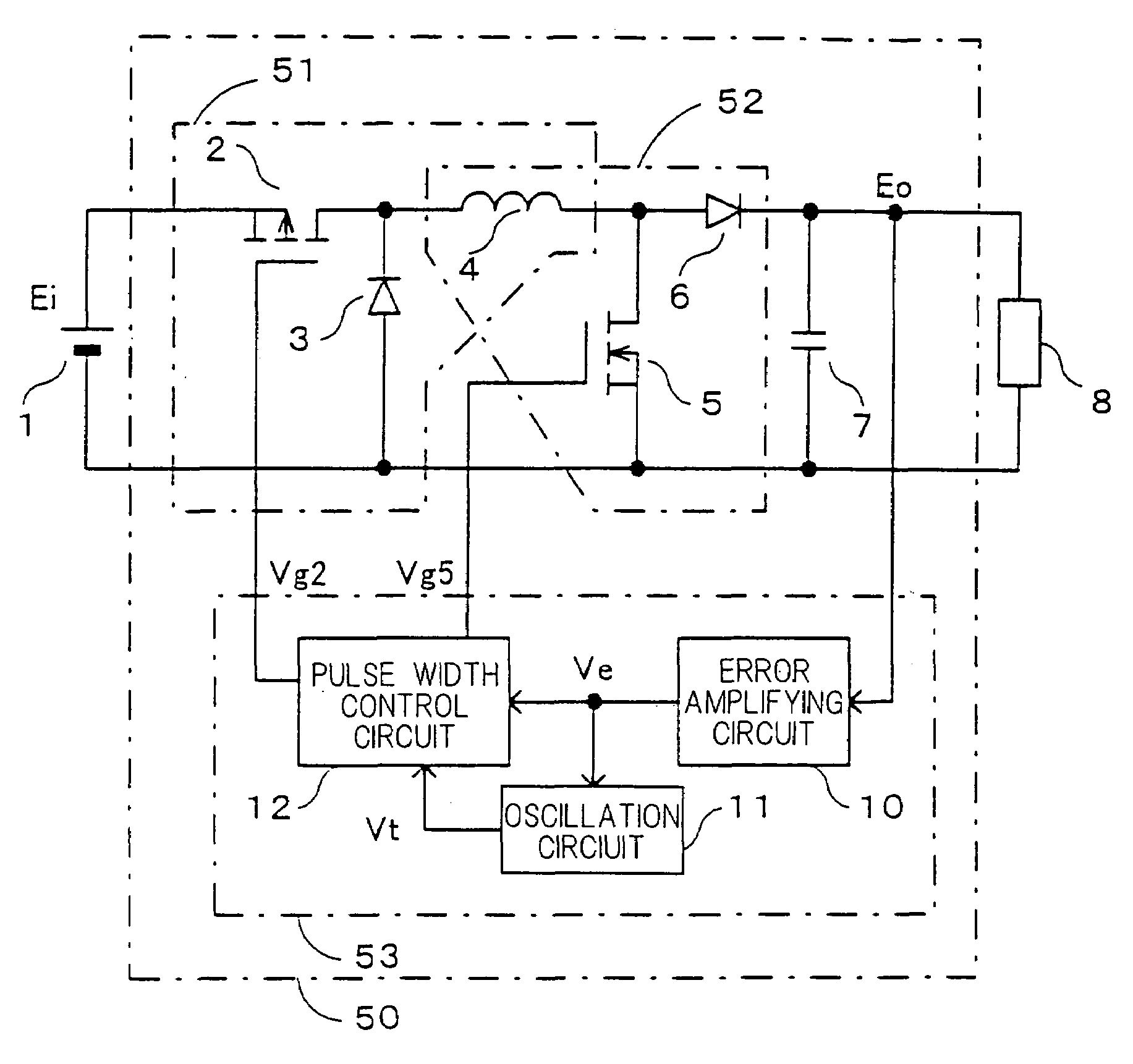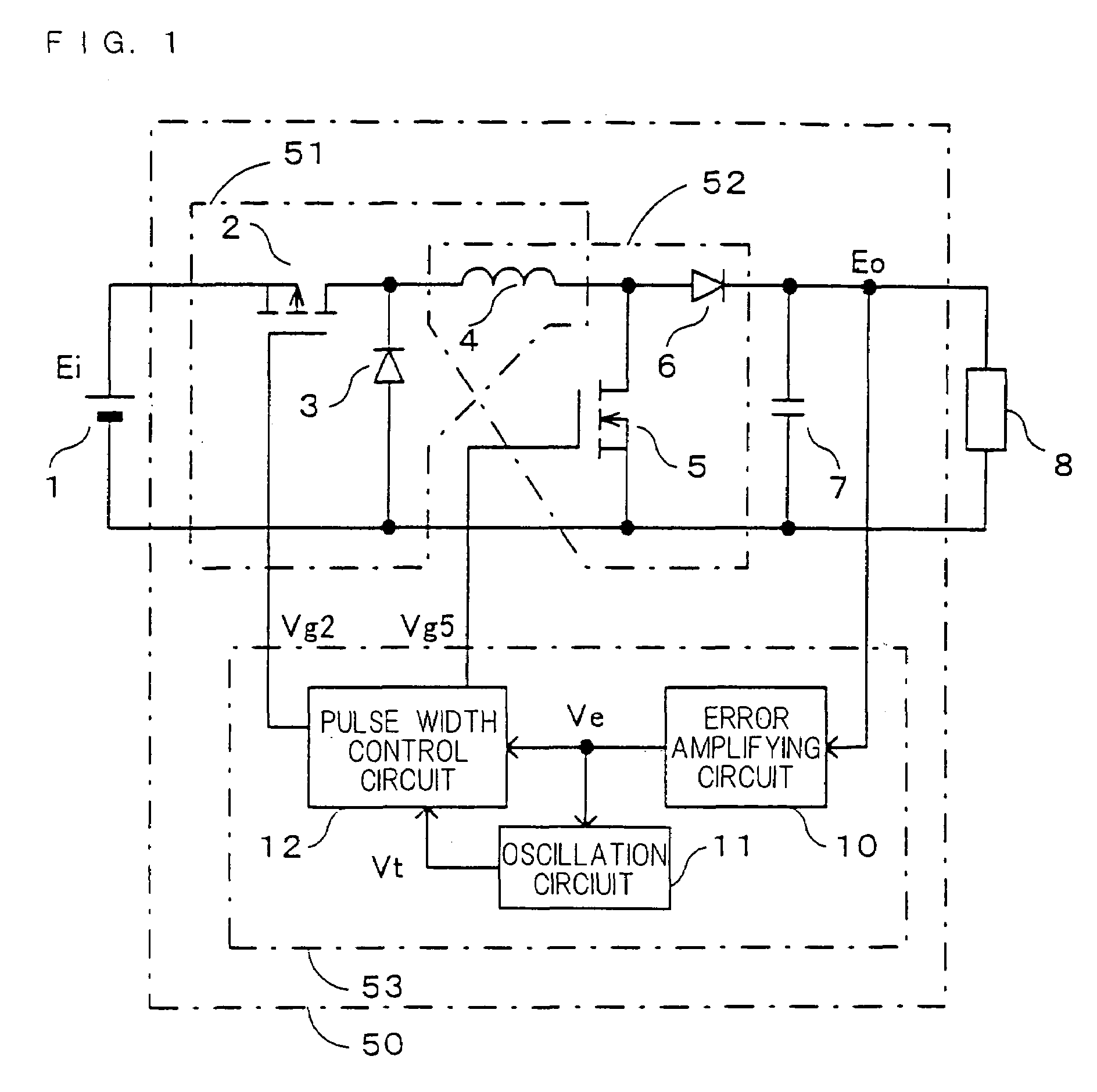DC-DC converter
a converter and dc technology, applied in the direction of dc-dc conversion, power conversion systems, instruments, etc., can solve the problems of increasing switching loss, complicated control circuit, design difficulties, etc., and achieve the effect of simplifying the configuration of the control section
- Summary
- Abstract
- Description
- Claims
- Application Information
AI Technical Summary
Benefits of technology
Problems solved by technology
Method used
Image
Examples
first embodiment
[0066]A first embodiment of the present invention will be described referring to FIG. 1 to FIG. 3.
[0067]FIG. 1 is a circuit diagram showing configuration of a DC—DC converter in accordance with the first embodiment of the present invention. In FIG. 1, the DC—DC converter 50 of the first embodiment comprises a voltage step-down converter 51 consisting of a first switch 2 formed of a P-channel MOSFET, which is connected to a direct current input power source 1 of a voltage Ei, a first rectifying section 3 as a diode and an inductor 4; a voltage step-up converter 52 consisting of a second switch 5 formed of N-channel MOSFET and a second rectifying section 6 as a diode, having the inductor 4 in common; and an output capacitor 7. A voltage Eo between both terminals of the output capacitor 7 is applied to a load 8 as a direct current output voltage.
[0068]The first switch 2, the inductor 4 and the second switch 5 are connected in series across a positive pole 1A and a negative pole 1B of t...
second embodiment
[0119]A DC—DC converter in accordance with a second embodiment of the present invention will be described referring to FIG. 4 and FIG. 5.
[0120]FIG. 4 is a circuit diagram showing the configuration of a control section 53A of the DC—DC converter in accordance with the second embodiment of the present invention. The control section 53A is incorporated into the converter section 50 in place of the control section 53 shown in FIG. 1 to constitute the DC—DC converter in accordance with the second embodiment. In the control section 53A of the DC—DC converter in accordance with the second embodiment, the error amplifying circuit 10 and the pulse width control circuit 12 are the same as those of the control section 53 of the DC—DC converter in accordance with the first embodiment. Further, as will be described in detail below, an oscillation circuit 11A is the same as the above-mentioned oscillation circuit 11 of the control section 53 except for a part. In FIG. 4, the same reference numera...
third embodiment
[0143]FIG. 6 is a block diagram and a circuit diagram of a control section 53B of a DC—DC converter in accordance with a third embodiment of the present invention. The DC—DC converter in accordance with the third embodiment is configured by replacing the control section 53 of the converter section 50 shown in FIG. 1 with the above-mentioned control section 53B. In FIG. 6, the error amplifying circuit 10 and the pulse width control circuit 12 are the same as those in FIG. 2 or FIG. 4, and therefore they are illustrated in block diagram. The same reference numerals are applied to elements in an oscillation circuit 11B having the same function and configuration as those of the oscillation circuit 11A shown in FIG. 4 and description thereof are omitted. The control section 53B of the DC—DC converter in accordance with the third embodiment is different from the control section 53A of the DC—DC converter in accordance with the second embodiment shown in FIG. 4 in that, in the oscillation ...
PUM
 Login to View More
Login to View More Abstract
Description
Claims
Application Information
 Login to View More
Login to View More - R&D
- Intellectual Property
- Life Sciences
- Materials
- Tech Scout
- Unparalleled Data Quality
- Higher Quality Content
- 60% Fewer Hallucinations
Browse by: Latest US Patents, China's latest patents, Technical Efficacy Thesaurus, Application Domain, Technology Topic, Popular Technical Reports.
© 2025 PatSnap. All rights reserved.Legal|Privacy policy|Modern Slavery Act Transparency Statement|Sitemap|About US| Contact US: help@patsnap.com



